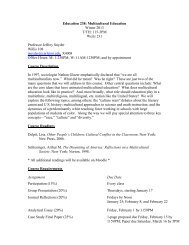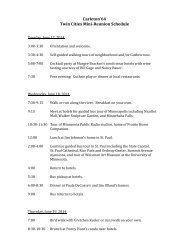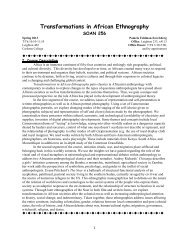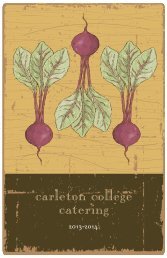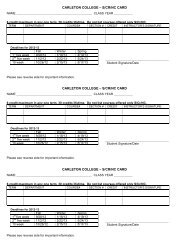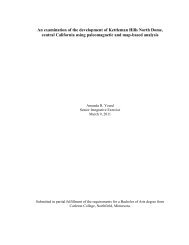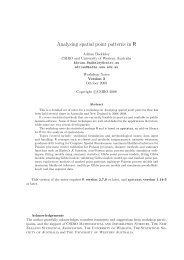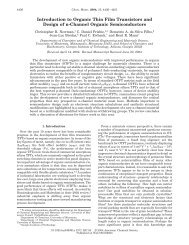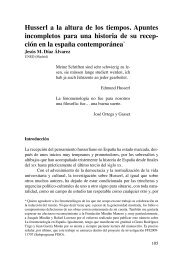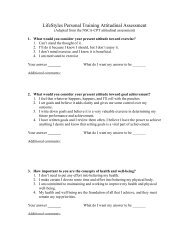babababababababababababababab the druid ... - Carleton College
babababababababababababababab the druid ... - Carleton College
babababababababababababababab the druid ... - Carleton College
Create successful ePaper yourself
Turn your PDF publications into a flip-book with our unique Google optimized e-Paper software.
community, it is drastically different from most o<strong>the</strong>r philosophical<br />
movements that have called <strong>the</strong>mselves “Druidic.”<br />
And yet <strong>the</strong> Neopagan Druids do have some fundamental concepts<br />
in common with <strong>the</strong> Paleopagan and Mesopagan Druids who<br />
preceded <strong>the</strong>m. Down through <strong>the</strong> ages, <strong>the</strong>ir communities have<br />
known how to tell who <strong>the</strong> Druids among <strong>the</strong>m were, because <strong>the</strong><br />
role of <strong>the</strong> Druid has always been clear—scholar, and artist, poet and<br />
priest, philosopher and magician—<strong>the</strong> one who seeks, preserves and<br />
extends <strong>the</strong> highest wisdom her or his people are capable of handling<br />
safely, and who uses <strong>the</strong> knowledge and inspiration for <strong>the</strong><br />
benefit of <strong>the</strong>ir community.<br />
The Path of <strong>the</strong> Druid, like that of <strong>the</strong> Brahmin, <strong>the</strong> Medicine<br />
Person, <strong>the</strong> Shaman or <strong>the</strong> Rabbi, is one of heavy responsibilities<br />
and hard work. But like <strong>the</strong>se o<strong>the</strong>rs, it is also a path of great rewards—physical,<br />
intellectual, artistic, magical and spiritual. For those<br />
who feel a link to <strong>the</strong> Paleopagan Celtic peoples, and who find <strong>the</strong>mselves<br />
wanting to use <strong>the</strong>ir highest talents to serve <strong>the</strong>ir communities,<br />
Druidism can be a challenging and exhilarating way of life to<br />
explore.<br />
323<br />
A Basic Wiccan Rite<br />
by Isaac Bonewits<br />
For <strong>the</strong> benefit of those Reformed Druids who have inquired as to<br />
exactly what goes on at a typical Neopagan Witchcraft ritual, and<br />
how it might differ from one of our own, we present <strong>the</strong> following<br />
Basic Wiccan Rite, in outline form. This is based primarily upon <strong>the</strong><br />
pattern developed by an Eclectic Reconstructionist Wicca organization<br />
in California. It is highly similar to that used by <strong>the</strong> majority of<br />
Neopagan Witchcraft movements in America. Astute readers will<br />
note that <strong>the</strong>re are no incantations, songs or names of particular<br />
deities in this outline. This is because each Coven chooses or invents<br />
its own and usually prefers to keep <strong>the</strong>se matters secret, in<br />
order to protect <strong>the</strong> delicate structure of <strong>the</strong> groupmind created by<br />
<strong>the</strong> system. The rituals also tend to work much better when <strong>the</strong><br />
Coven has written its own variations to <strong>the</strong> basic <strong>the</strong>me.<br />
There is nothing to ei<strong>the</strong>r prevent or encourage <strong>the</strong> use of this<br />
pattern by Reformed Druids of any Branch of <strong>the</strong> Reform; except, of<br />
course, that most Wiccans would not accept most Druids as competent<br />
to preside over such a ceremony. Isolated elements of this rite<br />
may , naturally, prove of use in <strong>the</strong> creation of new Druid Liturgies.<br />
Suggestions concerning <strong>the</strong> psychic technology of this rite and<br />
o<strong>the</strong>rs of a similar nature may be found in The Second Epistle of<br />
Isaac and in several of <strong>the</strong> books listed in A Bibliography of Druidism.<br />
1. Ritual baths beforehand, personal anointing, with special oils if<br />
desired, putting on of clean clo<strong>the</strong>s to travel to meeting site in.<br />
2. Upon arrival at meeting site, all immediately change into whatever<br />
clo<strong>the</strong>s (if any) will be worn for <strong>the</strong> rite. Leaders should arrive early<br />
in order to set up site properly, make sure materials are all on hand,<br />
see that musicians know <strong>the</strong>ir cues, etc.<br />
3. Altar is placed outside of where circle is to be and all tools, statues<br />
and o<strong>the</strong>r materials are set up on altar sturdily.<br />
4. Circle is marked out on floor or ground with tape, powder, flour<br />
or whatever. Those that use concentric circles mark out <strong>the</strong> proper<br />
ma<strong>the</strong>matical proportions and inscribe whatever symbols are used<br />
inside <strong>the</strong> concentric rings. Candles or torches are placed at <strong>the</strong> Four<br />
Quarters.<br />
5. Coveners assemble outside circle(s), two by two. Those groups<br />
that use scourging for purification do so now (3 + 7 + 9 +21 is <strong>the</strong><br />
common pattern). Musicians may start opening song; coveners enter<br />
circle being greeted by HP (High Priest) and Hps (High Priestess) or<br />
<strong>the</strong>ir assistants, usually with a kiss and a password. All file into <strong>the</strong><br />
circle clockwise, alternating (as much as possible) male and female,<br />
and distributing <strong>the</strong>mselves equally around <strong>the</strong> circle.<br />
6. If coveners are too far apart to hold hand, <strong>the</strong>y move closer to <strong>the</strong><br />
center of <strong>the</strong> circle until <strong>the</strong>y can. If <strong>the</strong>re are too many coveners in<br />
<strong>the</strong> circle, <strong>the</strong> rite should be stopped, <strong>the</strong> circle makers scolded, and<br />
<strong>the</strong> circle drawn all over again larger. Then start <strong>the</strong> rite again from<br />
<strong>the</strong> beginning.<br />
7. All coveners, including <strong>the</strong> leaders, join hands facing <strong>the</strong> outside<br />
of <strong>the</strong> circle. Music starts and <strong>the</strong> Hps leads a counter-clockwise<br />
dance around <strong>the</strong> circle. Men dance with <strong>the</strong>ir left heel kept off <strong>the</strong><br />
ground (a ref. to <strong>the</strong> Lame King motif). After at least one full circling,<br />
Hps lets go with her left hand and leads <strong>the</strong> dance into a slow inward<br />
spiral (<strong>the</strong> Labyrinth motif). When <strong>the</strong> spiral is as tight as it can get,<br />
Hps turns to her right and kisses <strong>the</strong> man next to her (symbol of<br />
awakening to passion and new life). She leads a new spiral outwards,<br />
this time clockwise. She and every woman kisses each man she comes<br />
to. The spiral eventually unwinds into a circle with all facing inwards<br />
and dancing clockwise.<br />
8. Assistants go outside circle and very carefully carry in altar. This is<br />
placed near or on <strong>the</strong> center of <strong>the</strong> circle and candles on it are lit.<br />
9. Hps and HP (or assistants) exorcise and consecrate Four Elements.



